- Arabic
- French
- Russian
- Spanish
- Portuguese
- Turkish
- Armenian
- English
- Albanian
- Amharic
- Azerbaijani
- Basque
- Belarusian
- Bengali
- Bosnian
- Bulgarian
- Catalan
- Cebuano
- Corsican
- Croatian
- Czech
- Danish
- Dutch
- Afrikaans
- Esperanto
- Estonian
- Finnish
- Frisian
- Galician
- Georgian
- German
- Greek
- Gujarati
- Haitian Creole
- hausa
- hawaiian
- Hebrew
- Hindi
- Miao
- Hungarian
- Icelandic
- igbo
- Indonesian
- irish
- Italian
- Japanese
- Javanese
- Kannada
- kazakh
- Khmer
- Rwandese
- Korean
- Kurdish
- Kyrgyz
- Lao
- Latin
- Latvian
- Lithuanian
- Luxembourgish
- Macedonian
- Malgashi
- Malay
- Malayalam
- Maltese
- Maori
- Marathi
- Mongolian
- Myanmar
- Nepali
- Norwegian
- Norwegian
- Occitan
- Pashto
- Persian
- Polish
- Punjabi
- Romanian
- Samoan
- Scottish Gaelic
- Serbian
- Sesotho
- Shona
- Sindhi
- Sinhala
- Slovak
- Slovenian
- Somali
- Sundanese
- Swahili
- Swedish
- Tagalog
- Tajik
- Tamil
- Tatar
- Telugu
- Thai
- Turkmen
- Ukrainian
- Urdu
- Uighur
- Uzbek
- Vietnamese
- Welsh
- Bantu
- Yiddish
- Yoruba
- Zulu
Říj . 04, 2024 02:54 Back to list
flat and v belt
Understanding Flat and V Belts Key Components in Mechanical Systems
In the realm of mechanical engineering, transmission systems play a crucial role in facilitating the movement of power from one component to another. Among the various types of transmission mechanisms, flat belts and V belts stand out as two predominant choices, each with its distinct advantages, applications, and design characteristics. This article explores the features, applications, and benefits of flat and V belts in various mechanical systems.
Flat Belts
Flat belts are made from a simple rectangular cross-section and are typically constructed from materials such as rubber, leather, or a composite material. Their design allows for a larger surface area in contact with the pulleys, resulting in effective power transmission over short to moderate distances. The key advantages of flat belts include flexibility, the ability to work with pulleys of different diameters, and their suitability for applications requiring high-speed operations.
Flat belts are commonly used in industries that involve conveyor systems, printing machines, and fan drive systems. Their smooth surface reduces slippage, enabling efficient power transfer. Moreover, flat belts can operate in environments where alignment is not perfect between pulleys since they can flex without significant strain. However, they require careful tension adjustments and alignment to ensure optimal performance.
V Belts
In contrast, V belts have a trapezoidal cross-section designed to fit snugly into corresponding V-shaped grooves on pulleys. This unique shape allows for greater frictional contact between the belt and the pulley, making V belts particularly effective in transmitting higher power levels. The design helps to minimize slippage and allows for better grip, making them suitable for more demanding applications.
flat and v belt

V belts are predominant in heavy machinery, automotive engines, and agricultural equipment. Their adaptability to varying load conditions—due to the dynamic tension they can maintain—delivers reliability in applications where sudden load changes are common. Moreover, V belts are built to operate silently, offering an enhanced user experience, particularly in consumer-oriented products.
Comparing Flat and V Belts
When comparing flat belts to V belts, the choice largely depends on the specific application and operational requirements. Flat belts are preferable for long-distance transmissions and applications that require minimal noise levels. Conversely, V belts excel in scenarios involving high loads and dynamic actions.
Both types of belts have a finite lifespan and require regular maintenance to ensure longevity and performance. This includes checking for wear, ensuring proper tension, and conducting regular inspections for any signs of damage.
Conclusion
In summary, flat and V belts serve as integral components in multiple mechanical systems, each bringing unique benefits to the table. Their design intricacies allow for various applications across diverse industries, making them indispensable in the realm of power transmission. Understanding the characteristics, advantages, and limitations of flat and V belts enables engineers and professionals to make informed decisions, optimizing performance and enhancing the efficiency of mechanical systems. As technology progresses, these belts will continue to evolve, further improving the reliability and functionality of a wide range of machinery.
-
Korean Auto Parts Timing Belt 24312-37500 For Hyundai/Kia
NewsMar.07,2025
-
7PK2300 90916-T2024 RIBBED BELT POLY V BELT PK BELT
NewsMar.07,2025
-
Chinese Auto Belt Factory 310-2M-22 For BMW/Mercedes-Benz
NewsMar.07,2025
-
Chinese Auto Belt Factory 310-2M-22 For BMW/Mercedes-Benz
NewsMar.07,2025
-
90916-02660 PK Belt 6PK1680 For Toyota
NewsMar.07,2025
-
drive belt serpentine belt
NewsMar.07,2025

